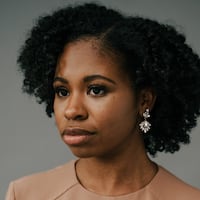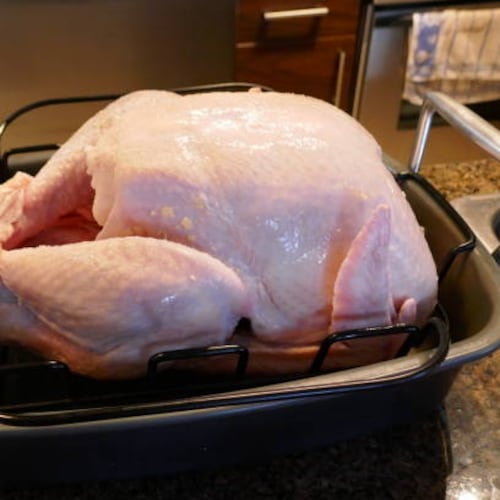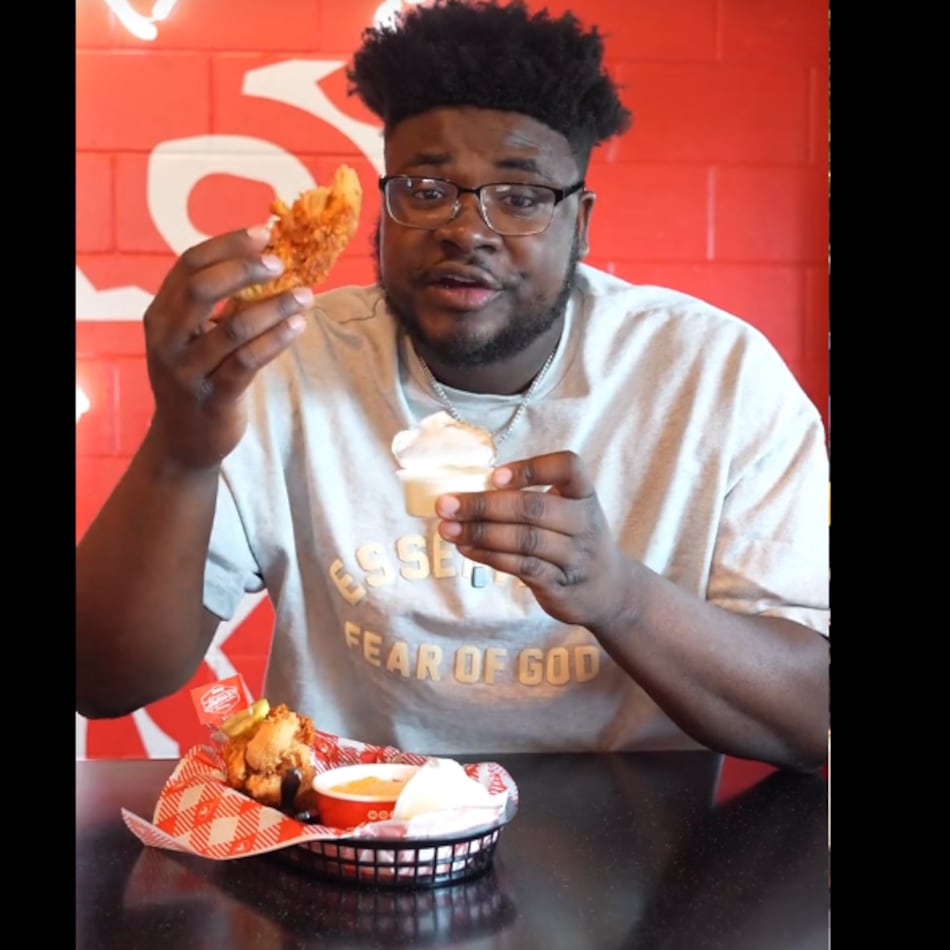A video of locals doing the Bart Simpson to Strafe’s “Set It Off” and Chubb Rock’s “Treat ‘em Right” makes the rounds online every few months on the social media accounts of Atlanta celebrities and nostalgia-themed aggregate pages dedicated to “Old Atlanta.”
At a glance, the music and fashion — from high top fades and mushroom haircuts to patterned shirts and backward baseball caps — suggest it was recorded on a regular club night in the early ‘90s. But a sign that reads “Atlanta Jams with Pepsi-Cola” is an indicator that this was a party strictly for teens.
Filmed during the short-lived televised teen party “Atlanta Jams,” the popular video captures a star-studded era of Atlanta’s nightlife that might otherwise have been relegated to the memories of the youth who attended. Goodie Mob’s Big Gipp posted the clip to Instagram recently with the caption, “A real Atlanta throwback!” eliciting comments from viewers who shouted out their neighborhoods and favorite popular teen clubs from the ‘90s.
Throughout the late ‘80s and ‘90s, Atlanta became home to several under-21 clubs that not only entertained teens, they provided a vital platform for the city’s burgeoning hip-hop scene, hosting performances from up-and-coming artists ranging from Kris Kross to Outkast. Arguably, one of the most influential teen clubs at that time was Shyran’s Showcase.
A place of their own
Shyran Blakely, 78, didn’t intend to start a trend when she founded Shyran’s Showcase.
In the early ‘80s, she owned Shyran’s Jewelry, which originally operated in a shopping plaza on Moreland Avenue. The jewelry store sold other items, including T-shirts, but it was the records she sold in the back of the store that enticed the young crowd. Blakely says kids would hang out and dance, sometimes rehearsing at the store for 10 hours. Eventually, she set them up on the sidewalk outside to perform for customers with her brother serving as their DJ. Sometimes, the kids would perform for adults at local nightclubs.
But Blakely wanted them to have a place where they could perform in front of their peers. “If I ever get enough money, a dime above breathing, I’m going to get them a place to perform,” she promised herself.
When Blakely was a teenager, a young girl she used to babysit died. In her adolescent brain, she rationalized that if she had a lot of children — a dozen or so felt reasonable — she wouldn’t have to contend with the grief of potentially losing one. She only ended up having one biological child, Edward Hood Jr., aka DJ Ed, though. For a short time, she operated a nursery. Then, the kids at the jewelry store became her surrogate children.
The south Atlanta native opened the first iteration of Shyran’s Showcase around 1981 in a tin shed behind Eddie’s Skating Rink on Gresham Road. Looking for a way to pay the rent for the space, she charged kids an entrance fee to watch one another perform. “On Fridays and Saturdays, they would come in and do their own little talent show. That’s how Shyran’s Showcase started.”
Blakely operated in that location through the early ‘80s before taking a break to focus on other professional endeavors. By 1989, she was back in the business, helping with a teen party called Motions before reopening Shyran’s Showcase off Gresham Road in 1990.
On Friday and Saturday nights, teens ages 14 to 17 would line up to get inside Shyran’s Showcase to watch dance groups such as The Crowd Pleasers perform and hear their favorite dance songs. DJ Ed, who juggled working at the teen club with playing football for Southwest DeKalb High School. He played music popular at the local skating rink, like “Planet Rock” by Afrika Bambaataa and the Soul Sonic Force, but also hip-hop, which wasn’t yet played on mainstream radio.
There were other outlets for teen entertainment — high school talent shows, Jellybeans Skating Rink and the Phyllis Wheatley YMCA. But Shyran’s Showcase combined all of the elements of those options with a bit of edge. Blakely lectured the kids about underage drinking, drugs and sex, but she also hosted performances by adult dancers Cherry and Sherry participating in a Sexy as You Wanna Be dance contest.
At its peak in the early ‘90s, 2000 people would cram inside Shyran’s Showcase, with even more hanging out in the parking lot where she eventually built a basketball court.
Credit: Courtesy of Carol Blackmon
Credit: Courtesy of Carol Blackmon
Hip-hop’s local tastemakers
Daron Fears was a teenager at Columbia High School when he started attending Shyran’s Showcase and hosting local talent shows. Eventually, he began working on V-103′s rap program, “The Fresh Party,” and in this capacity, he was able to help Blakely promote the teen club and facilitate performances from rising artists. “Believe it or not, Shyran actually gave me my first car. It was a black Volvo,” he says, noting she was tired of him arriving late to work.
Ask Blakely about the acts who visited her club, and she’ll rattle off a list of ‘90s stars including Chris Tucker, Usher, Silk, 69 Boyz and more. Jermaine Dupri used to visit the club as a dancer before he eventually brought his group Kris Kross to perform their single “Jump.”
“I put them little boys up on (the stage) and they did that little jump jump song. I was jumping. Everybody was jumping. That song hit just like that,” Blakely says, snapping her fingers.
The performance many attendees seem to remember from that time, however, was from the R&B group Jodeci. The group was there to perform their single “Forever My Lady,” which would shoot to No. 1 on the Billboard Hot R&B / Hip-Hop Singles & Tracks chart in the following weeks.
The crowd didn’t recognize the group or the eventual hit at the time, though. “Nobody had ever heard of them,” says DJ Swiff, a former Shyran’s Showcase DJ. Teens, who wanted to dance instead of listen to the slow jam booed the group. Blakely threatened to close early if the teens reacted the same way toward the follow-up act, Boyz II Men. They got a more welcoming response.
2 Live Crew performed there, too. Blakely recalls telling Uncle Luke his dancers couldn’t perform in G-strings, instead allowing them to wear bathing suits. Teens “were hanging off the ceiling when Luke and them came. It was just so packed,” she says.
By 1991, Shyran wasn’t the only teen club where these acts could perform. For roughly a year, a film crew visited local clubs to host a teen party called Atlanta Jams that would air on channel 36. Fears and former V-103 radio host Carol Blackmon were among the hosts.
Traveling from clubs such as Club XS in southeast Atlanta to 559 in southwest Atlanta’s West End neighborhood, Atlanta Jams would often host several hundred teens from midday into the evening.
“Teens hungered for a place to go to see their friends outside of school and to see the dancers and the entertainment aspect. Maybe they weren’t able to go to a concert, but they got everything in those spaces,” Blackmon says.
There was some overlap between the musicians playing Atlanta Jams and Shyran’s Showcase, including Jodeci, Kris Kross, New Edition and Yo-Yo.
“Shyran probably launched quite a few careers,” Fears says. “The same thing with what we were doing at Atlanta Jams.”
“The powers that be and the people [who] were the decision makers, they knew that Shyran’s Showcase and “Atlanta Jams” were important,” Blackmon adds.
Credit: Courtesy of Carol Blackmon
Credit: Courtesy of Carol Blackmon
Rise of youth crime
For all of the ways teen clubs were celebrated by patrons and performers, there was a growing concern about a rise in youth crime and whether or not these venues were a hotbed for violence.
According to the U.S. Department of Justice, the number of homicide cases handled in the U.S. juvenile courts increased 144% between 1985 and 1994. The Georgia Department of Children and Youth Services sought additional funding in 1994 to build new youth prisons to account for overcrowding in its facilities. A study released the following year conducted by the Emory Center for Inquiry Control found that 70% of respondents in Fulton and 49% in DeKalb believed youth crime to be “a very serious problem” in their counties. The concern about a local increase in youth violence mirrored national trends.
In 1990, Atlanta enacted a curfew — its first since the one enacted during the Atlanta child murders in the late ‘70s / early ‘80s. Anyone younger than 17 was required to be inside before midnight on Fridays and Saturdays. Several other metro area cities followed suit.
In DeKalb County, where Shyran’s Showcase operated until 4 a.m., officials failed to pass a curfew. Still, the pressure on the county’s youth hangout spots continued. “We want teens to find other havens besides the teen clubs,” a supporter of the proposed curfew told the AJC in 1993.
Blakely hired more than a dozen off-duty police officers to patrol inside and outside of Shyran’s Showcase each weekend and installed metal detectors at the entrance, but she grew frustrated with the negative attention associated with the teen club. When more than 100 teens were arrested in the adjoining parking lot throughout 1992 for fighting, drinking or drug possession, it was linked back to Blakely and her club. When a 13-year-old was killed by crossfire in 1993, police said it was preceded by an argument by two teens outside of the club.
“I got tired of being the blame for every child that got hurt,” Blakely says.
Shyran’s Showcase wasn’t the only teen hangout receiving this type of attention, either. Even the places that weren’t traditionally visited by Black teens such as the 911 Teen Club in Lawrenceville or the After Deck Night Club in Peachtree City had to contend with being praised for giving youth a place to congregate and criticized in circumstances when things went awry.
A collaborative effort
In hopes of keeping teens out of the court system, an enterprising duo of novice club owners set out to work with officials in creating a safe place for teens to socialize in Atlanta.
As juvenile probation officers in Atlanta, Careatha Daniels and Milfred Zeno were witness to the fallout over teen crime. They grew tired of punishment being the only solution for misbehavior among youth. At the time, they say, the Fulton County court system was seeing a lot of kids who had violated Atlanta’s curfew.
“A majority of the children who came into the court system were African American and basically poor. Their constant complaint was that they kept getting into trouble because they were bored,” Daniels says. “We found that children usually got into trouble after school when everything had shutdown.”
DeKalb County had Shyran’s Showcase, but there was no equivalent in Fulton County or the city of Atlanta for youth, she says.
In 1993, Daniels and Zeno used their personal funds and a $5 entrance fee to open the youth center My Brother’s Keeper (MBK) in a former movie theater located in the Westgate Plaza on Campbellton Road. They quickly garnered support from community leaders and MARTA. The latter would sometimes offer bus passes to teens looking for a ride home from the venue.
MBK was more than just a place for youth to party and host talent shows. In addition to a teen club that could accommodate roughly 1,500 teens, there was also an auditorium space that seated 800 people, and they hosted a number of youth programs, some of which were sponsored by the city of Atlanta.
MBK worked with V-103 to bring in new artists to perform and Warner Records provided funding to help them stay open.
DJ Jelly worked with TLC’s Left Eye to host an event at MBK, and he brought in artists such as Raheem the Dream and Kilo Ali to perform. Other musical acts who performed in the space include Usher, Goodie Mob and Outkast.
In order for a musician to make it through the front door of MBK, Zeno says, they had to spread a positive message. “One of the artists that came through that we had an opportunity to spend a little time with was Andre (3000) with Outkast, who said that to become what you want to be you have to know where you’ve come from and know where it is you want to go,” he says. “We used those people to attract the children to look at life a little bit differently.”
But ultimately, “the music and dancing, that was the carrot to draw them in,” Daniels adds.
All things must come to an end
In 1994, Blakely closed Shyran’s Showcase on Gresham Road. Although she’d go on to open several iterations of Shyran’s Showcase in other locations through the early 2000s, most people remember the Gresham Road location as the heyday of teen clubs in Atlanta. Today, she remains in the hospitality business as owner of O’Riley’s Entertainment Sports Bar and Grill on Covington Highway in Decatur.
Southwest Atlanta’s MBK closed several years later, in 1998, as the children who once attended got older and spaces such as the former Magic Johnson’s movie theater opened nearby at Greenbriar Mall.
The owners of Shyran’s Showcase and MBK, along with the former hosts of Atlanta Jams, have all received requests to host reunions for their former patrons, but so far nothing is in the works. “A lot of folks are not just grown,” Blackmon says. “They’re parents and grandparents now.”
For now, those Friday and Saturday nights will just have to live on in the memories of those who witnessed them firsthand, through their oral accounts and the sharing of a few digitized videos on social media roughly three decades later.
About the Author
Keep Reading
The Latest
Featured






